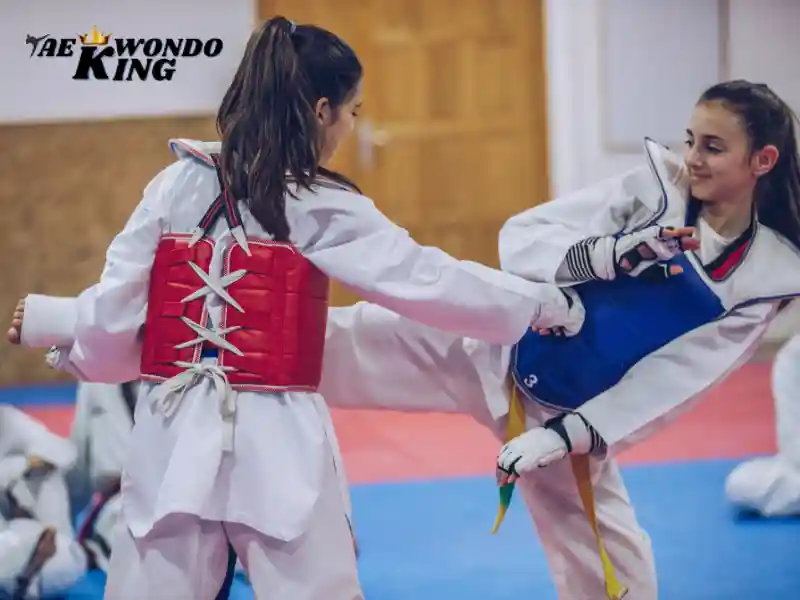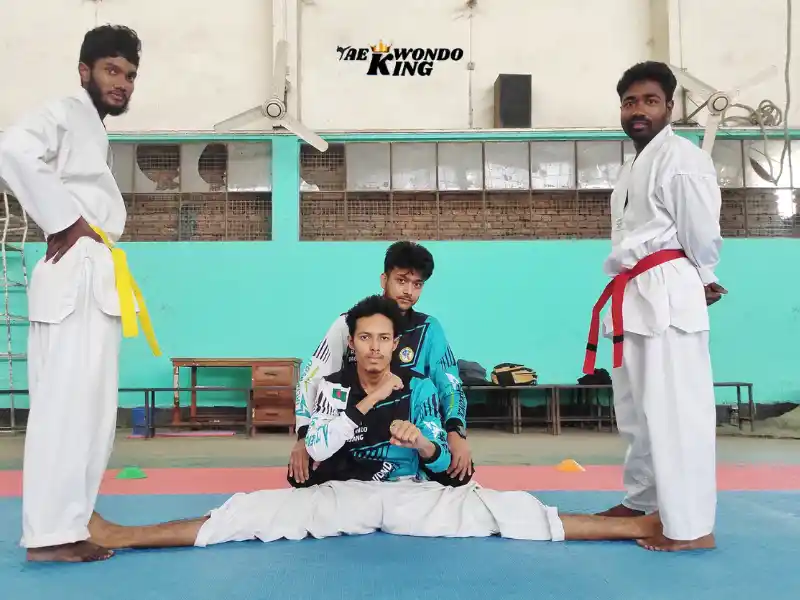
As a Taekwondo practitioner with extensive experience in national and international competitions, coaching, and refereeing, I have witnessed firsthand the critical role that flexibility plays in mastering this martial art. In this article, I will delve into the significance of flexibility in Taekwondo and explore how it contributes to performance, injury prevention, and overall martial arts proficiency.
Flexibility is crucial in Taekwondo because it allows practitioners to execute high kicks, and quick movements, and maintain balance. It also plays a key role in injury prevention and contributes to overall physical health. Let’s delve into why flexibility is the most important aspect of Taekwondo.
Understanding Flexibility in Taekwondo:
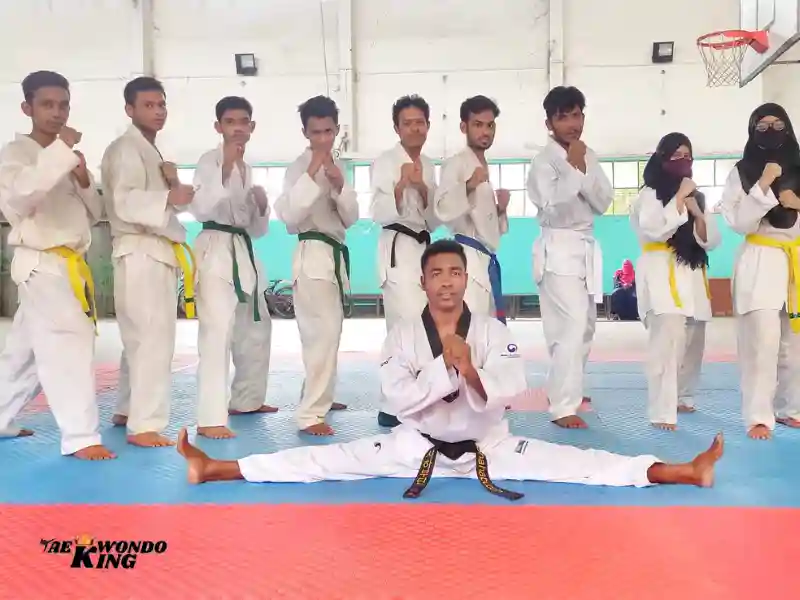
Flexibility is the ability of the body to move freely and easily through a full range of motion. In Taekwondo, flexibility is essential for executing various techniques with precision, power, and efficiency. From high kicks and dynamic footwork to agile defensive maneuvers, flexibility enables practitioners to perform with grace and fluidity, enhancing both aesthetic appeal and combat effectiveness.
The Importance of Flexibility in Taekwondo:
1. Enhanced Performance:
Flexibility is the cornerstone of effective technique execution in Taekwondo. The ability to achieve and maintain optimal joint mobility and muscle elasticity allows practitioners to perform kicks, strikes, and blocks with greater speed, accuracy, and power. A flexible body facilitates smoother transitions between movements, enabling practitioners to flow seamlessly from one technique to the next, whether in forms, sparring, or breaking competitions.
2. Injury Prevention:
Maintaining adequate flexibility is crucial for reducing the risk of injuries in Taekwondo. By improving joint mobility and muscle suppleness, flexibility helps to mitigate the strain and stress placed on the body during training and competition. Increased flexibility reduces the likelihood of muscle strains, ligament sprains, and joint injuries, allowing practitioners to train more safely and effectively over the long term.
3. Greater Range of Techniques:
Flexibility opens the door to a wider repertoire of techniques in Taekwondo. By expanding the range of motion in joints and muscles, practitioners can execute advanced kicks, such as high kicks, spinning kicks, and jumping kicks, with greater ease and proficiency. Flexibility also enables practitioners to adapt their techniques to different situations and opponents, enhancing versatility and strategic adaptability in combat scenarios.
4. Improved Balance and Stability:
Flexibility is closely linked to balance and stability in Taekwondo. A flexible body enables practitioners to maintain proper alignment and posture throughout movements, enhancing stability and control. Improved balance reduces the risk of falls and enhances the ability to recover from off-balance situations, providing a solid foundation for executing techniques with precision and confidence.
5. Mental and Emotional Benefits:
Flexibility extends beyond the physical realm and encompasses mental and emotional aspects as well. In Taekwondo, the discipline required to develop flexibility fosters patience, perseverance, and mindfulness. Stretching and flexibility training serve as opportunities for practitioners to cultivate focus, concentration, and self-awareness, promoting mental clarity and emotional resilience both on and off the mat.
Strategies for Improving Flexibility in Taekwondo:
- Regular Stretching Routine: Incorporate dynamic and static stretching exercises into your daily training regimen to improve flexibility and range of motion in key muscle groups used in Taekwondo techniques.
- Yoga and Pilates: Supplement your Taekwondo training with yoga or Pilates sessions to enhance flexibility, balance, and body awareness. These practices offer valuable cross-training benefits that complement the physical and mental demands of Taekwondo.
- Foam Rolling and Self-Myofascial Release: Utilize foam rollers, massage balls, and other self-myofascial release tools to alleviate muscle tension and improve tissue elasticity, enhancing overall flexibility and recovery.
- Partner Stretching: Incorporate partner stretching drills into your training sessions to deepen stretches and improve flexibility through passive assistance and resistance from a training partner.
- Mindful Breathing Techniques: Practice deep breathing and relaxation techniques during stretching exercises to enhance muscle relaxation, reduce tension, and promote greater flexibility and mobility.
How does Taekwondo improve flexibility?
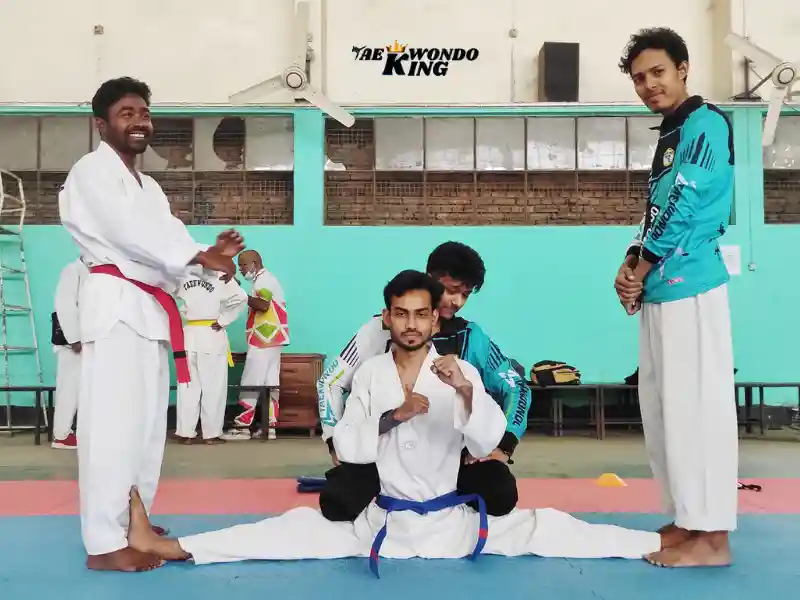
Taekwondo is a martial art that emphasizes dynamic movements, high kicks, and agile footwork, all of which require a high degree of flexibility. Here’s how Taekwondo improves flexibility:
Dynamic Warm-Up Exercises:
Taekwondo training typically begins with a series of dynamic warm-up exercises such as leg swings, arm circles, and torso twists. These movements help to increase blood flow to the muscles, improve joint mobility, and prepare the body for more intense activity, thereby enhancing overall flexibility.
Stretching Routines:
Stretching is an integral part of Taekwondo training, and practitioners engage in both static and dynamic stretching exercises to improve flexibility. Static stretching involves holding a stretch position for a prolonged period, targeting specific muscle groups used in Taekwondo techniques. Dynamic stretching involves moving the body through a full range of motion in a controlled manner, which helps to improve flexibility, mobility, and muscle coordination.
Kicking Drills:
Taekwondo training includes a wide variety of kicking drills designed to improve flexibility, balance, and technique. Practitioners perform kicks at different heights and angles, gradually increasing their range of motion over time. Through consistent practice, students develop greater flexibility in the hips, legs, and lower back, allowing them to execute kicks with speed, power, and precision.
Poomsae Practice:
Poomsae or Forms, or patterns of movements, are an essential component of Taekwondo training. Practicing forms requires fluid transitions between stances, kicks, and blocks, which helps to improve flexibility, coordination, and body awareness. As practitioners progress through higher belt levels, they learn more complex forms that challenge their flexibility and control, further enhancing their overall martial arts proficiency.
Partner Stretching:
In addition to individual stretching exercises, Taekwondo training often includes partner stretching drills. These drills involve one partner assisting the other in deepening stretches by providing gentle pressure or resistance. Partner stretching helps to improve flexibility in areas that may be difficult to target on one’s own, such as the hamstrings, groin, and shoulders.
Cool-Down Exercises:
At the end of each training session, Taekwondo practitioners engage in cool-down exercises to help relax and lengthen the muscles. These exercises often include gentle stretching and foam rolling to alleviate muscle tension and promote recovery, ultimately improving flexibility over time.
Overall, Taekwondo training provides a comprehensive approach to improving flexibility, incorporating a variety of exercises and techniques that target different muscle groups and movement patterns. With consistent practice and dedication, practitioners can achieve significant gains in flexibility, enhancing their performance, reducing the risk of injuries, and maximizing their martial arts potential.
Taekwondo Stretching Exercises for Beginners
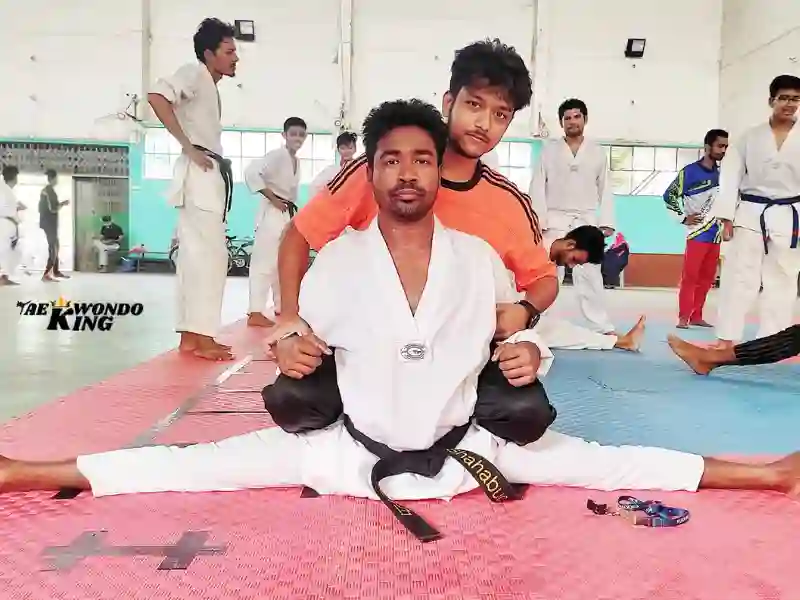
For beginners in Taekwondo, it’s important to start with simple stretching exercises to gradually improve flexibility and mobility. Here are some basic stretching exercises suitable for beginners:
Neck Stretch:
- Sit or stand tall with your shoulders relaxed.
- Slowly tilt your head to one side, bringing your ear towards your shoulder.
- Hold the stretch for 15-30 seconds, feeling a gentle stretch along the side of your neck.
- Repeat on the other side.
Shoulder Stretch:
- Bring one arm across your body at shoulder height.
- Use your other hand to gently press the arm towards your chest until you feel a stretch in your shoulder.
- Hold for 15-30 seconds and then switch sides.
Triceps Stretch:
- Reach one arm overhead and bend it so that your hand reaches down towards the middle of your back.
- Use your other hand to gently press on the elbow, feeling a stretch along the back of your arm.
- Hold for 15-30 seconds and then switch sides.
Hamstring Stretch:
- Sit on the floor with one leg extended straight in front of you and the other leg bent.
- Lean forward from your hips, keeping your back straight, and reach towards your toes.
- Hold the stretch for 15-30 seconds, feeling a gentle stretch along the back of your extended leg.
- Switch legs and repeat.
Quad Stretch:
- Stand tall and lift one foot towards your buttocks, grasping the ankle with your hand.
- Gently pull your heel towards your buttocks until you feel a stretch in the front of your thigh.
- Keep your knees close together and your torso upright.
- Hold for 15-30 seconds and then switch legs.
Calf Stretch:
- Stand facing a wall and place both hands on the wall at shoulder height.
- Step one foot back and press the heel into the floor while keeping the back leg straight.
- Lean forward slightly until you feel a stretch in the calf of the back leg.
- Hold for 15-30 seconds and then switch legs.
Groin Stretch (Butterfly Stretch):
- Sit on the floor with the soles of your feet together and your knees bent out to the sides.
- Hold onto your ankles and gently press your knees towards the floor with your elbows.
- Keep your back straight and lean forward slightly, feeling a stretch in your inner thighs.
- Hold for 15-30 seconds.
Back Stretch (Cat-Cow Stretch):
- Start on your hands and knees with your wrists directly under your shoulders and your knees under your hips.
- Inhale as you arch your back, dropping your belly towards the floor and lifting your head and tailbone towards the ceiling (Cow Pose).
- Exhale as you round your back, tucking your chin towards your chest and pressing through your hands and knees (Cat Pose).
- Continue flowing between Cat and Cow Poses for 5-10 breaths.
Ankle Circles:
- Sit on the floor with your legs extended in front of you.
- Lift one foot off the floor and rotate your ankle in a circular motion, moving clockwise for several rotations.
- Then switch to counterclockwise rotations.
- Repeat with the other foot.
Wrist Stretch:
- Extend one arm in front of you with the palm facing down.
- Use your other hand to gently press down on the fingertips until you feel a stretch in your wrist and forearm.
- Hold for 15-30 seconds and then switch sides.
It’s important to perform these stretching exercises gently and gradually, avoiding any sudden or jerky movements. Hold each stretch for 15-30 seconds and breathe deeply throughout to help relax the muscles. Stretching should be done after a proper warm-up or at the end of a workout session when the muscles are warm and more pliable. As you progress in your Taekwondo training, you can gradually increase the intensity and duration of your stretching routine to continue improving flexibility and mobility.
How do I make my legs flexible for Taekwondo?
Flexibility is very important in Taekwondo because it helps with kicking techniques and agility. To improve flexibility in your legs, you should add stretching exercises to your daily routine. Focus on stretching your hamstrings, quadriceps, calves, and hip flexors. Yoga or Pilates can also help improve overall flexibility. Consistent stretching practice will help you achieve greater flexibility and improve your performance in Taekwondo. Additionally, warming up before training or competitions can help prevent injury and improve flexibility.
Why stretching is necessary before doing any physical activities like Taekwondo?
Stretching before participating in physical activities such as Taekwondo is important for preventing injuries and improving performance. It helps to warm up the muscles, increase blood flow, and improve flexibility, which can enhance overall performance and reduce the risk of strains or sprains.
By stretching before engaging in physical activities, you are preparing your body for the demands of the activity and helping to prevent potential injuries. It also allows you to mentally prepare for the activity and improve your focus. Overall, stretching is necessary before engaging in physical activities like Taekwondo to ensure that your body is properly prepared and to minimize the risk of injury.
How do Taekwondo fighters become flexible?
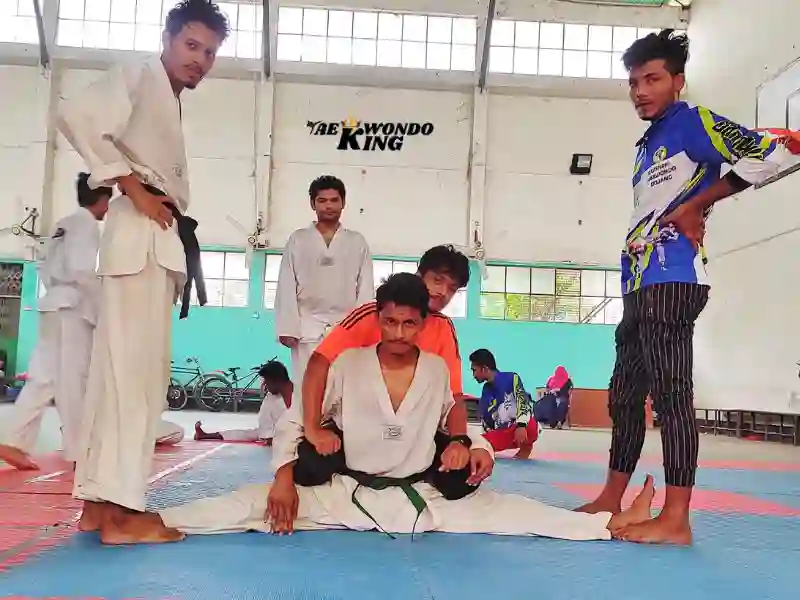
Taekwondo fighters achieve flexibility through consistent training and stretching exercises. Flexibility is crucial for executing high kicks and rapid movements in Taekwondo. Fighters regularly engage in dynamic and static stretching to enhance their range of motion and reduce the risk of injuries. Moreover, regular practice of Taekwondo forms and techniques also contributes to improved flexibility. In summary, the combination of targeted training and stretching exercises enables Taekwondo fighters to cultivate the flexibility necessary for their sport.
Here’s how Taekwondo fighters typically improve flexibility:
- Regular Stretching Routine
- Dynamic Warm-Up Exercises
- Kicking Drills
- Forms Practice
- Partner Stretching
- Foam Rolling and Self-Myofascial Release
- Consistent Training and Practice
Overall, flexibility is a fundamental component of Taekwondo training that enhances performance, reduces the risk of injuries, and enables fighters to execute techniques with precision and efficiency. Through dedicated practice and perseverance, Taekwondo fighters can achieve and maintain optimal flexibility, empowering them to reach their full potential in the sport.
Why is stretching important to Taekwondo?
Stretching is crucial in Taekwondo as it can enhance flexibility, decrease the likelihood of injury, and improve overall performance. Regular stretching can help practitioners improve their range of motion, as well as increase the power and speed of their kicks and punches. It also promotes muscle relaxation and prevents stiffness, which is essential for executing complex and dynamic movements in Taekwondo. Furthermore, stretching can improve blood circulation and promote better balance and coordination, all of which are important for successful Taekwondo practice.
Do I need to be flexible for Taekwondo?
Yes, flexibility is an important aspect of Taekwondo. It allows practitioners to perform various kicks and movements with ease and agility, while also helping to prevent injuries and improve overall physical performance. Regular stretching and flexibility exercises are essential for training in Taekwondo, as they help improve flexibility and reach one’s full potential in the sport.
How does Taekwondo improve flexibility for Beginners?
Taekwondo is a fantastic way for beginners to enhance their flexibility. The kicking and stretching exercises in Taekwondo help to expand the range of motion in your joints and muscles. As you advance in your training, you’ll see improvements in flexibility, agility, and overall body control. This can be very helpful for beginners seeking to improve their physical fitness and coordination. Regular practice of Taekwondo can lead to gradual increases in flexibility and overall athletic performance.
What stretches should a beginner do?
As a beginner, it’s important to start with gentle and simple stretches to avoid injury. Some great stretches for beginners include neck stretches, shoulder rolls, arm and wrist stretches, standing forward bends, and seated hamstring stretches. These stretches help to improve flexibility and reduce muscle tension, making them a great starting point for anyone new to stretching. It’s important to listen to your body and not push yourself too hard when starting with stretching. Gradually increasing the intensity of your stretches as your flexibility improves is key to preventing injury and seeing progress.
Can a nonflexible person do Taekwondo?
Yes, it is possible for a person who is not very flexible to still participate in Taekwondo. While flexibility is a valuable trait in Taekwondo, it is not a mandatory prerequisite for starting training. With regular practice, flexibility can be developed and improved over time. It is more important to concentrate on building strength, coordination, and mastering the techniques of Taekwondo. As you advance in your training, you will naturally notice improvements in flexibility.
What are the warm-up exercises for Taekwondo?
Before you begin any intense physical activity, such as Taekwondo, it’s crucial to properly warm up your body. This can include exercises like jogging or jumping jacks to raise your heart rate, dynamic stretching to enhance flexibility and mobility, and light practice of Taekwondo techniques to prepare your muscles for the training ahead. It’s recommended to spend at least 10-15 minutes on warm-up exercises to reduce the risk of injury and enhance your performance in Taekwondo.
Taekwondo Stretching Routine pdf for Beginners Free Download
If you’re interested in enhancing your flexibility and overall performance in Taekwondo, it’s important to incorporate a stretching routine into your training. For beginners, this is crucial for building strength and flexibility. We offer a free PDF download of a beginner’s Taekwondo stretching routine that can help you optimize your training and succeed in your martial arts practice.
How do you increase flexibility in Martial Arts?
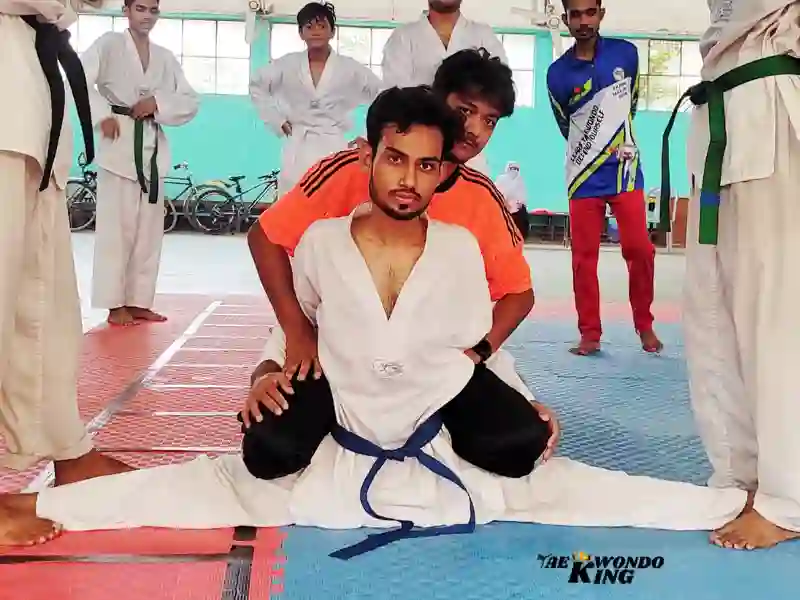
Increasing flexibility in martial arts requires a combination of targeted stretching exercises, dynamic movements, and consistent training. Here are some effective ways to improve flexibility in martial arts:
- Regular Stretching Routine
- Dynamic Warm-Up Exercises
- Kicking Drills
- Forms/Poomsae Practice
- Partner Stretching
- Foam Rolling and Self-Myofascial Release
- Consistent Training and Practice
How does flexibility help in a fight?
Having flexibility in a fight can be advantageous. It helps you move more freely and quickly, making it easier to avoid and respond to your opponent’s attacks. Flexibility also reduces the risk of muscle strains and injuries during combat, as it allows your body to move smoothly and adapt to sudden movements. Plus, being flexible makes it easier to perform different fighting techniques and maneuvers effectively. Overall, flexibility is essential for improving physical performance and resilience in a fight.
How can I be flexible in 10 days?
Improving your flexibility in 10 days is possible with consistent effort and dedication. You can start by incorporating daily stretching exercises into your routine, such as yoga or Pilates, which can be done at home or in a class setting. Staying hydrated and eating a balanced diet is important to support your body’s flexibility. Listen to your body and avoid pushing yourself too hard to prevent injury. With time and persistence, you can achieve your flexibility goals in just 10 days.
What are the Pros and Cons of Taekwondo Flexibility?
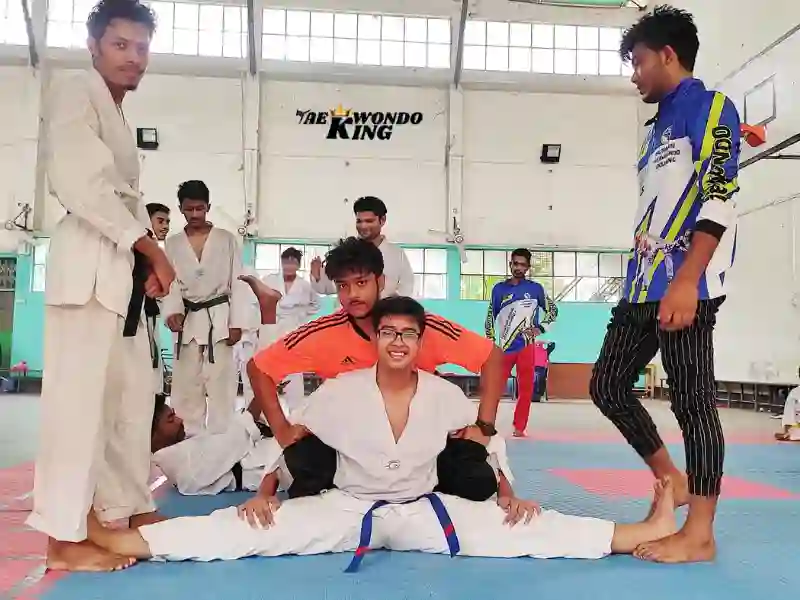
Flexibility is a key component of Taekwondo training, offering various advantages but presenting some challenges. Let’s explore the pros and cons of Taekwondo flexibility:
Pros of Taekwondo Flexibility:
- Improved Technique Execution: Enhanced flexibility allows practitioners to execute techniques with a greater range of motion and precision, leading to more powerful and effective strikes, kicks, and blocks.
- Reduced Risk of Injury: Flexible muscles and joints are less prone to strains, sprains, and other injuries during training and competition. Maintaining good flexibility can help prevent overuse injuries and improve overall athletic performance.
- Enhanced Performance: Increased flexibility enables practitioners to perform dynamic movements, such as high kicks, spinning kicks, and jumping techniques, with greater ease and proficiency. This can lead to higher scores in form competitions and more successful outcomes in sparring matches.
- Better Balance and Coordination: Flexibility contributes to better balance and coordination, allowing practitioners to maintain stability and control during complex movements and transitions between techniques.
- Adaptability in Combat: Flexible practitioners can adapt to different situations and opponents more effectively by adjusting their techniques and footwork to match the demands of the moment. This adaptability can give them a strategic advantage in sparring and self-defense scenarios.
Cons of Taekwondo Flexibility:
- Risk of Overstretching: Pushing flexibility too far or too quickly can lead to overstretching, which may result in muscle strains, ligament sprains, or joint injuries. It’s essential to practice flexibility exercises safely and gradually to avoid overexertion.
- Potential for Muscle Imbalances: Focusing solely on increasing flexibility without addressing strength and stability can lead to muscle imbalances, where certain muscles become overly flexible while others remain tight or weak. This imbalance may increase the risk of injury and compromise overall performance.
- Time and Effort Required: Developing and maintaining flexibility in Taekwondo requires consistent effort and dedication. It takes time to see significant improvements in flexibility, and practitioners must commit to regular stretching and flexibility exercises as part of their training routine.
- Conflicts with Strength Training: Flexibility training may conflict with strength training exercises, as excessive flexibility can reduce muscle tension and power output. Finding a balance between flexibility and strength training is essential for optimal athletic performance in Taekwondo.
- Individual Variability: Flexibility levels vary among individuals due to factors such as genetics, age, and previous training experience. Some practitioners may naturally possess greater flexibility, while others may need to work harder to achieve similar results. It’s important to recognize and respect these differences while striving to improve flexibility.
Overall, the pros of Taekwondo flexibility, such as improved technique execution and reduced risk of injury, outweigh the cons when approached sensibly and with proper guidance. By incorporating safe and effective flexibility training into their regimen, Taekwondo practitioners can maximize their performance potential and enhance their overall martial arts experience.
Conclusion:
Flexibility is the cornerstone of success in Taekwondo, encompassing physical, mental, and emotional dimensions that are essential for achieving mastery in the martial art. From enhancing performance and injury prevention to promoting balance and stability, flexibility plays a vital role in every aspect of Taekwondo training and competition. By prioritizing flexibility as an integral component of their training regimen, practitioners can unlock their full potential and embark on a journey of continuous growth, development, and excellence in Taekwondo.
As someone deeply immersed in the world of Taekwondo, I can attest to the transformative power of flexibility in shaping not only physical prowess but also mental fortitude and spiritual resilience. By embracing flexibility as a core tenet of Taekwondo philosophy, practitioners can transcend limitations, overcome challenges, and embody the true essence of martial arts mastery.
FAQ
Does being flexible help with fighting?
Flexibility is crucial in fighting as it enhances agility, speed, and range of motion, enabling fighters to execute techniques with precision and evade attacks effectively. It reduces the risk of injury, improves balance, and allows for fluid transitions between offensive and defensive maneuvers, enhancing overall performance in combat situations.
How important is flexibility?
Flexibility is highly important in various aspects of life, including physical fitness, sports performance, and overall health. It improves mobility, reduces the risk of injury, enhances athletic performance, and promotes better posture and range of motion. Additionally, flexibility contributes to relaxation and stress relief, aiding in overall well-being and quality of life.
Do you need to be flexible for Karate?
While flexibility is beneficial in Karate, it’s not an absolute requirement. Karate emphasizes techniques that accommodate different body types and abilities. While flexibility enhances performance and allows for more extensive movement, practitioners can still excel with varying levels of flexibility by focusing on technique, strength, and agility.
How to be flexible?
To become more flexible, incorporate regular stretching exercises into your routine. Focus on dynamic stretches before workouts to warm up muscles and static stretches after workouts to increase flexibility. Yoga and Pilates classes can also help improve flexibility. Consistency is key; aim to stretch daily and gradually increase the intensity and duration of stretches over time.
How can I become flexible?
Becoming more flexible requires consistent stretching and mobility exercises. Here’s a step-by-step guide:
- Start with Warm-Up
- Dynamic Stretching
- Static Stretching
- Target Specific Areas
- Use Proper Technique
- Breathe and Relax
- Be Consistent
- Stay Hydrated and Rest
- Consider Yoga or Pilates
- Listen to Your Body
Following these steps and incorporating flexibility exercises into your routine can gradually improve your flexibility and mobility over time.
Why am I not flexible?
Several factors can contribute to limited flexibility, including genetics, lack of regular stretching, muscle imbalances, sedentary lifestyle, injury history, and aging. Consistent stretching and mobility exercises, proper hydration, and addressing any underlying issues can help improve flexibility over time.
Can I be flexible at 18?
Yes, absolutely! Flexibility can be developed at any age, including 18. You can improve your flexibility over time with consistent stretching and mobility exercises, proper technique, and patience. Starting at a younger age can provide some advantages, but it’s never too late to become more flexible.
Why stretching is important in Martial Arts?
Stretching is crucial in Martial Arts for several reasons. It enhances flexibility, mobility, and range of motion, allowing practitioners to perform techniques more effectively. Stretching also reduces the risk of injury, improves muscle coordination, promotes relaxation, and enhances overall performance in training and combat situations.
What fighting styles require flexibility?
Several fighting styles benefit from flexibility, including:
- Taekwondo
- Capoeira
- Muay Thai
- Brazilian Jiu-Jitsu
- Wushu
- Karate
- Kung Fu
- Kickboxing
- Gymnastics and Freestyle Wrestling.
Overall, while flexibility may not be a strict requirement for all fighting styles, it can greatly enhance performance and effectiveness in combat situations.

Founder, Owner, and CEO of TaekwondoKing.
He is one of the top 100 martial artists in the World and among the top 20 referees in Bangladesh.
Ehatasamul Alom is an esteemed Kukkiwon Certified Taekwondo 3rd Dan Black Belt with over 15 years of experience in this dynamic martial art. Born in Rajshahi, Bangladesh, Ehatasamul’s journey with Taekwondo began at the tender age of seven. His passion led him to compete at national and international levels, where he has bagged numerous awards and honors. He is also a member of the Taekwondo National Referee Panel.
With a Bachelor’s degree in Sports Science from the prestigious Rajshahi University, Ehatasamul has a deep understanding of the technical and scientific aspects of martial arts and some other martial arts.
In 2022, Ehatasamul created the “TaekwondoKing.com” blog to share his knowledge and Real experiences. His articles focus on Taekwondo training techniques, competition strategies, and the art’s rich history and philosophy. He also writes about the importance of mental fortitude and discipline, key aspects of his teaching philosophy. His goal is to inspire both beginners and seasoned practitioners worldwide through insightful and engaging content.
If you need any help, contact Ehatasamul Alom at any time.




